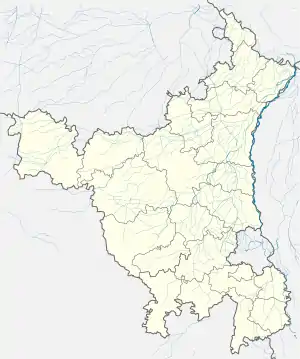Mangar Bani
Mangar Bani sacred grove hill forest next to Mangar village on Delhi-Haryana border, is in Faridabad tehsil of Faridabad district in the Indian state of Haryana.[1][2][3][4]
Mangar Bani | |
|---|---|
Village | |
 Mangar Bani Location in Haryana, India  Mangar Bani Mangar Bani (India) | |
| Coordinates: 28.3787474°N 77.1731615°E | |
| Country | India |
| State | Haryana |
| District | Faridabad |
| Time zone | UTC+5.30 (IST) |
It is an important biodiversity area within the Northern Aravalli leopard wildlife corridor stretching from Sariska Tiger Reserve to Delhi. Historical place around sanctuary are Badkhal Lake (6km northeast), 10th century ancient Surajkund reservoir (15 km north) and Anangpur Dam (16 km north), Damdama Lake, Tughlaqabad Fort and Adilabad ruins (both in Delhi), Chhatarpur Temple (in Delhi).[5] It is contiguous to the seasonal waterfalls in Pali-Dhuaj-Kot villages of Faridabad,[6] and the Asola Bhatti Wildlife Sanctuary. There are several dozen lakes formed in the abandoned open pit mines in and around the area.
Etymology
Mangar Bani, is a Haryanvi dialect term which means the "Mangar Vana" in Hindi or Sanskrit and "the forest of Mangar" in English.
Location
Mangar village is 14 kilometres (8.7 mi) from the Faridabad.[4] Mangar Bani and other villages such as Gwal Pahari and Bandhwari, lie in the eco-sensitive area of at-risk forested hills of Southern Delhi Ridge in Aravalli range.
History
Mangar is a 700 years old village nestled in the rocky hills covered with native trees unique to the Aravalli range, the oldest Plateau mountains in India.[7]
Demography
In 2011, it had a population of about 1965 persons living in 368 households.[4]
Mangar Bani hills biodiversity area
Forest
Mangar Bani along with neighbouring villages of Gwal Pahari, Baliawas and Bandhwari, which lies near the forested parts of Southern Delhi Ridge of Aravalli range, is an ecologically sensitive under threat biodiversity area dotted with disused mining pits. The flora, fauna, and ecology has degraded which severely needs restoration by replacing the invasive Vilayati kikar weed with the 3-layer cover of native grass, shrubs and trees. This area lies in the habitat of leopards. 95% of the forest is covered with the slow-growing dhau tree (anogeissus pendula).[8] Mangar Bani has native plant species such as Dhau and wild eagle can be seen here.[9]
Conservation
Mangar Bani has been studied by the biologists who found it to be a High-Biodiversity Zone. It is one of the last remaining natural tropical forest in the Aravalli range. It has more than 30 native tree species thriving along with the 100 native shrubs and herbs, all of which provide shelter to the wildlife, animals and rare birds, leopards. It acts as an important source of ground water recharge. Mangar Bani, which was panchayat common land till 1970 was converted to private land in the 1980s, and in 2012 the union environment ministry put the Mangar Development plan on hold. Haryana chief minister Manohar Lal Khattar declared it a protected forest in 2015 with a 500-meter buffer zone.[10]
Gudariya Das Baba temple
Gudariya Das Baba temple is 2 km to the northwest of Mangar village. This ancient temple provides the status of sacred grove to Mangar Bani.[9] According to the local oral tradition, the baba (saint) Gudariya Das protects this bani (forest) and punishes anyone who damages this forest.[8]
Lulu Lake
Lulu Lake wetland is nestled on the hills of Mangar Bani, 6 km to the southwest of Mangar village and 4 km south of Gudariya Das Baba temple. Its near mount Gaga Lulu, a small hill.
Tribal jewellery museum
Mangar Tribal Jewellery museum, established by the Sterre Sharma the wife of former INC union minister Satish Sharma, has jewellery from all over India including the tribes of northeast India.[9] Jewellery is made from the glass, bone, brass, white metal, silver and gold plate.[7]
Concerns
Encroachment, illegal tree felling, illegal construction are major threats to the forest.[11] Nearby Bandhwari Waste-to-energy plant and landfill is already causing an environmental threat to the sensitive ecology by leeching toxic pollutants in the forest and aquifers. In 2017, National Green Tribunal (NGT) ordered the Central Pollution Control Board (CPCB) to the test the groundwater sample near Bandhwari plant.[12][13][14]
See also
- Anangpur Dam
- Delhi Ridge
- Gurugram leopard and deer safari
- Leopards of Haryana
- Surajkund
- Surajkund International Crafts Mela
- National Parks & Wildlife Sanctuaries of Haryana
References
- July 30, Navneet Mendiratta; July 30, 2017UPDATED; Ist, 2017 17:46. "Here's why Mangar Bani can be your ideal weekend getaway". India Today. India: India Today. Retrieved 16 January 2019.CS1 maint: numeric names: authors list (link)
- "Saving Mangar Bani: Why returning grove to original custodians may be only solution - Times of India". The Times of India. India: The Times of India. Retrieved 16 January 2019.
- "Haryana's Mangar Bani forest demarcated at last". hindustantimes.com/. India: Hindustan Times. 3 September 2015. Retrieved 16 January 2019.
- Mangar, Census of India 2011.
- ASOLA BHATTI WILD LIFE SANCTUARY Archived 16 August 2011 at the Wayback Machine, Department of Forest, Delhi Government
- पाली गांव की पहाड़ियों पर डैम बनाकर रोका जाएगा झरनों का पानी
- Best Places to Visit Mangar, Faridabad, Mangar Tourist Places
- Unhappy bani, downtoearth.org.in, 7 June 2015.
- Mangar, a hidden jewel near Delhi, The Hindu BusinessLine, 19 Sep 2017.
- Mangar Bani forest: Preserve biodiversity to ensure ecological security, Hindustan Times, 18 June 2015.
- Over 500 trees cut in Mangar Bani, forest land levelled, Hindustan Times, 7 Dec 2015.
- NGT asks CPCB to test groundwater sample near Bandhwari plant, India Today, 1 Aug 2017.
- Only 30 villagers turn up for impact study, Times of India, 2018.
- Bandhwari shut, forest bears waste brunt, PressReader.

